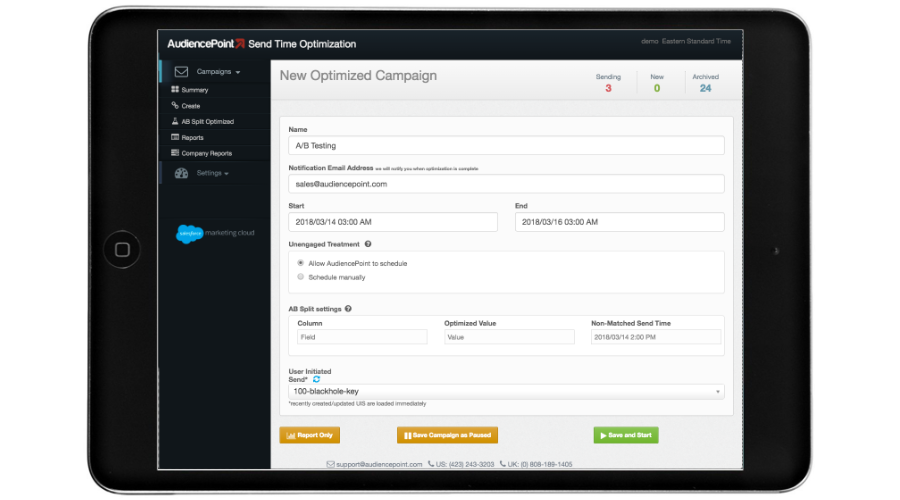AudiencePoint is thrilled to announce our new integration with Klaviyo! AudiencePoint is looking for partners to pilot our...
If you’re trying to improve your email strategy, you’ve likely heard of email marketing KPIs. If you’re wondering what KPIs for email are, the best ones to track, or how to implement them into your email engagement strategy, this article will provide examples to help you do just that. Keep reading to learn more.
What Are Key Performance Indicators?
Key performance indicators (KPIs) are email metrics that track and measure the success of marketing emails. Tracking and optimizing emails for KPIs will help you understand what parts of your email strategy are performing well and which could use improvements.
What Are the 5 Key Performance Indicators?
If you want a good baseline for how your emails are performing, there are five main KPIs you can track. The five most common email KPIs are:
- Open rate: Measures the percent of recipients that open an email out of the total emails delivered. However, Apple MPP has affected how this metric is tracked, so you must exclude Apple MPP opens to get accurate open rate metrics.
- Click rate: The percent of recipients that click a link out of the total emails sent.
- Conversion rate: The percentage of recipients that take a targeted action, such as making a purchase, from the total emails sent.
- Bounce rate: Measures how many emails bounce (aren’t accepted by inbox providers) from the total emails sent.
- Unsubscribe rate: The number of recipients that unsubscribe from the total number of emails delivered.
If you track each of these five KPIs, you should have a good idea of how your email content is performing.
What Are Good KPI Examples in 2022?
Seeing examples of how KPIs can be used will help you understand how to implement them into your email marketing strategy.
5 KPIs Examples
Here are examples of using all five of the most important KPIs to optimize an email strategy.
Example #1 – Using Open Rate to Improve Marketing Emails
A business that sells fitness equipment starts tracking email KPIs and notices their open rate is 12%, excluding Apple MPP opens. A good email open rate for most companies is between 17-28%, so this would signify they have a low open rate.
The company then makes changes to its upcoming email strategy to boost open rates. They decide to make subject lines more relevant to consumer needs by emphasizing keywords and topics like “weight loss” and “build muscle.” They also send some email content with special offers revolving around these goals.
By implementing these changes into their subject lines and the relevance of their email content, they are able to increase their open rates to 18%.
Example #2 – Using Click Rate to Improve Email Campaigns
A jewelry company is sending email content, but they realize their click rate is only 1.5%, which is well below the average click rate of 2.62%. With this knowledge, they look at their email content and see their calls to action (CTAs) aren’t very clear.
They decide to adjust their CTAs for their upcoming Valentine’s email campaign. At the end of their emails, they add the CTA: “Amaze them with something special this Valentine’s Day. Click here to see our full product selection.” This change helps increase their click rates to 3.5% for this email campaign.
Example #3 – Using Conversion Rate to Improve Emails
A music streaming service is trying to get more free trial signups through email, but they notice their conversion rate is only 1%. A good email conversion rate is anything between 2-5%, so they want to boost their campaigns into that range.
Upon looking through their email content, they notice their email design doesn’t make the CTA stand out from the rest of the body copy. They also decided to edit the body copy to include more information about the benefits of the streaming service and improve the free trial landing page to reflect these changes.
By doing this, they are able to boost their conversion rate to 2.5%.
Example #4 – Using Bounce Rate to Improve Marketing Emails
A software company notices their bounce rate has increased to 3% recently. Email bounce rates above 2% are a means for concern, so they decide to take action and fix this.
They notice that the significant growth they have seen in their email list due to the growing popularity of their software combined with some invalid email addresses is likely causing emails to bounce.
To fix this, they start using email sender software to improve deliverability. They also remove all invalid emails from their list. This helps them reduce their bounce rate to 0.4%, which is a good rate to achieve.
Example #5 – Using Unsubscribe Rate to Improve Emails
A clothing brand notices they are getting a 2% unsubscribe rate for every marketing email they send. To figure out what the problem is, they look at their content and signup process for their email list.
The company notices that since they’ve been collecting email addresses for their list during the checkout process of clothing sales, it may not be clear to customers that they are signing up to receive regular email content.
The company decides to implement a double-opt-in during the email sign-up process and make some improvements to the email content to ensure it is relevant to their customers. Over time, this helps them reduce their unsubscribe rate to 0.1%.
How are KPI Metrics Used?
Email KPI metrics are used as the above examples have outlined. Companies can track KPIs from their marketing email campaigns, see what numbers need improvements, and make necessary changes to improve these metrics. If you would like help with this process, AudiencePoint’s email insight software is an excellent option.
How AudiencePoint Can Help with Your Email Marketing
AudiencePoint can help you make sense of email KPIs. Companies with large email lists or brand owners who don’t know much about email marketing can get confused with the overwhelming number of KPIs that can be tracked for email.
AudiencePoint makes this process easy by analyzing subscriber data and getting an idea of how your subscribers interact with their inboxes, to give you actionable insights on improvements you can make to your email strategy. This will help you implement steps like optimizing email send times, re-engaging inactive subscribers, and segmenting your email list.
To get more information about how AudiencePoint can help you get the benefits of email marketing, contact us today.





